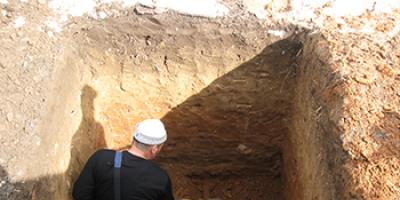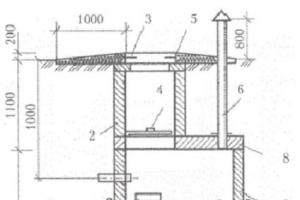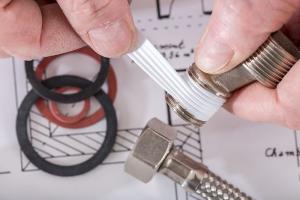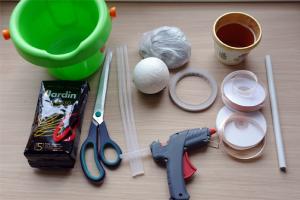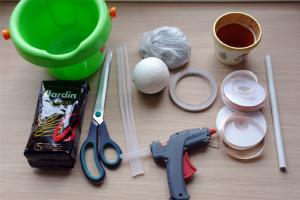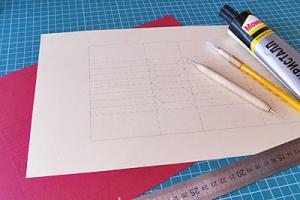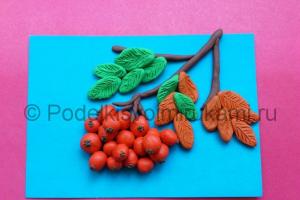Serjant 06-05-2006 10:59
In the rifled one there are notes from Flint, there will be notes from Serjanta.
So:. Let's begin.
Knife first.
Called "Bogorodsk knife"(Fig. 1). Designed for both rough and fine workmanship on wood. For rough work means for handing over to the workpiece the desired shape. Approximately trim so that the silhouette can be guessed. For example, whittling a spoon. For a thin one, for example, cut out fingers on a small wooden toy, cut out the face of an animal, etc. Speaking of toys. This knife got its name from the village of Bogorodskoye, Moscow region, where they cut, which has been famous throughout the world for several centuries wooden toy. As can be seen from the figure (Fig. 1), the knife is simple in shape and also simple in manufacture.
How to do Bogorodsky knife.
Would need:
1. A piece of steel. The ideal option for wood carvers is a mechanical saw blade (they cut rails with this saw and similar pieces of iron). The grade of steel does not play a special role. It doesn’t really matter whether it’s P6, P9, P6M5 or the really tricky P3AM3F2. This is all wonderful material. The thickness of these canvases is usually 1.8:2.3 mm. Are looking for required sizes piece of linen. You can buy canvas at any construction market.
2. Tree. Or rather, a couple of linden or birch plates. Evenly planed and dry.
Why linden or birch? This wood is very good at absorbing the sweat from the hand that comes into the wood carving process. But still, linden is preferable, although it is inferior to birch in terms of fur. properties.
3. PVA glue or any other hardening wood glue. It is possible epoxy resin. Moment glue and the like are not suitable; they do not hold the glued seam.
Sharpening the blade. We choose the dimensions of the blade and shank based on what we will do with this knife. If you roughly plan wood, then we make the blade larger, 70-90 mm, more is possible, but not necessary. If delicate work, then smaller, 30-60 mm. Shank:. We leave as much as we don’t mind. On the shank, using a sharpener or grinder, we make a bunch of “teeth”, notches or whatever else you call them. This will serve as a good fastener in the tree. We sharpen the blade; razor sharpening with clay will make the cut softer, and the blade will not get stuck in the wood. (see Fig. 1). We sharpen the blade and straighten it to the point of shaving hair (we use our own carcass). After sharpening, we wrap the blade with paper and electrical tape so as not to cut ourselves when installing and processing the handle.
We attach a shank to one of the wooden plates and trace the outline of the shank with a pencil. We hollow out a groove in the plate with a depth equal to the thickness of the blade. Blade, after insertion into wooden plate should not protrude, it may even be necessary for it to be slightly below the plane of the tree by 0.1..0.2 mm. There is no need to worry, the glue will fill this gap. In principle, you should get what is shown in Fig. 2. On the wood planes to be glued, using the sharp tip of a knife, apply a mesh for better penetration of the glue. Apply glue liberally, insert the blade into the groove, and press the second plate. We tighten this entire structure with clamps or clamp it in a vice until the glue dries completely. For PVA this is usually a day.
When the glue dries, shape the handle into an oval shape. I deliberately do not give any cross-sectional dimensions; everyone can choose what suits their hand, how it will be comfortable to hold and how it will be correct. We carefully grind the handle, but without fanaticism; there is no need to grind it to a “cat-like” state. There is also no need to soak it in oil or any other nasty thing like cyanoacrylate, let the wood nourish the sweat from your hand.
Sometimes it is useful (but not necessary) on the handle, closer to the blade (step back 5 mm from the edge of the handle), to sharpen a narrow groove with a file, and wrap it with wire or thick cotton thread and soak it with glue. Make the winding not wide, 10:15 mm wide, so that the winding and the handle are flush. Such strengthening of the structure is necessary for power work or when repairing a knife, when you are lazy to make a new handle.
It is useful to have several Bogorodsk knives, different sizes and with different sharpening angles. Personally, I have 5 of them.
KNIFE - JOIN
The name comes from the fact that the knife has a beveled blade. Well, that's not the point:
The knife is used for cutting through material, cutting veneer, trimming contours, various types thread, type flat-relief geometric carving, Kudrinskaya, etc. This knife is also called a shoe knife, but, as far as I could find out, a shoe knife is distinguished by a one-sided (chisel) sharpening of the blade. Although not always. General form and dimensions are shown in Fig. 3
The knife manufacturing technology is exactly the same as the Bogorodsky knife. The only difference is that the handle of the knife is adjusted in such a way that it is convenient to hold the knife with a reverse grip, with the blade facing you. This is the basic holding of the knife in the hand. The number of jamb knives a carver has is also not regulated by any rules or traditions. I have about 10 of them, all different.
Lazy cat 06-05-2006 11:16
A big, truly inhuman thank you.
Just to give an example finished goods and samples of work (how and what to cut with this stuff).
(Dreams - you can make an educational film....)
Serjant 06-05-2006 11:46
A complete description of the production of the casket. I used the blunt knife and the Bogorodsky knife to the fullest extent.
drachun 15-07-2006 13:37
These handles are new.
Vik_Tor 10-03-2007 01:14
Guys, why is it so little?
There are countless shapes of wood cutters, but here I would definitely mention a cutter in the form of a small chisel. You can even make a hand hacksaw for metal out of canvas; the blade is short and not wide; such a knife sometimes makes life a lot easier.
And special thanks for the Bogorodsky knife, I haven’t used it yet.
Serjant 10-03-2007 08:52
Hmmm??? and how will the production of a “small chisel” and other knives and chisels from a piece of fur linen differ from the above technology?? blade sharpening angles?? What else do you need?? post the entire list of tools used??
The number of knives a carver has is also not regulated by any rules or traditions. Who is this hanging for??
Vik_Tor 10-03-2007 11:24
I didn’t want to offend the highly respected “beaver maniac”, if this happened - sorry.
When I read the title of the topic, I expected more, so to continue the topic I wrote about a chisel (it personally often helped me, for example, for finishing the holes for the shank) - in case it came in handy for someone. Alas, it doesn't seem to be useful :-((
McS 15-08-2007 23:07
About the chisel - useful thing. But he made them from broken needle files. It's fast and cuts well. 1mm, 2mm and 3mm, for different purposes
Serjant 15-08-2007 23:36
Compared to the cutting properties of quick-cutters, the tooling (some U10, U12 in my opinion) from which the needle files are made was not lying around...
14771 16-08-2007 16:01
quote: Originally posted by drachun:
Finished, very high-quality blades (only with round handles) are sold at VERNISAGE (Partizanskaya metro station). Climb the steps to the second tier, turn left and take twenty-seven steps....
These handles are new.
Kuznetsov is selling this. quality.
Yongert 08-01-2008 04:28
All my life I considered the one without a heel to be a joint
and the current is sharp with a heel - it was always used to cut with the heel (grandfather taught it)))
very convenient, control of force and depth of cut,
only the handle is slightly different in shape, with the end of the handle resting on the palm and
the heel protrudes further from the handle, and the handle is almost like Bogorodsky’s
Forex 08-01-2008 06:35
Yongert, it would be interesting to look at photos of your tools and work. If my grandfather taught, then the old school must show the class!!! =)
Yongert 08-01-2008 19:06
unfortunately, when I left home, everything was left there, including tools and crafts,
Now I’ve slowly started making the instrument when I have some free time.
Everyone can create! It doesn’t matter whether you are a professional artist or an amateur, even if you have never touched paint, the Red Pencil art market will help you gain freedom of expression. Our store is a special area where you can not only find the goods you need, but also meet like-minded people, take part in master classes and chat in a friendly atmosphere.
Why do most artists choose "Red Pencil"?
Under the “Red Pencil” trademark there are five retail stores and an online store with delivery throughout Russia, each of which is a partner-licensee of the retail chain. They choose us to do more, to see, to draw, to evaluate new materials. We constantly deal with creative individuals and know what a real artist needs:
- Want to find everything you need in one place? We offer more than 40,000 items of goods from domestic and foreign manufacturers. Moreover, we offer products not only for artists, but also for sculptors, woodcarvers, decoupage artists, etc. We are sure that in our store you will definitely find what you need.
- Hoping to save money? Here you will find the most favorable prices for goods for artists in Moscow. Most of Products in our store are sold at the manufacturer's recommended price. We give discounts to birthday people, TS members, pupils and students of art institutions, as well as their parents and teachers. And our regular and wholesale customers also receive discount cards as a gift.
- Need professional advice? The sellers of our online store for artists will tell you in detail about the product and even give recommendations on its use. After all, most of our employees have professional art education and are constantly developing in this direction.
- Are you immersed in the creative process and don’t want to waste time shopping? We will deliver art supplies ourselves to any address in Moscow and the Moscow region. Moreover, if you ordered products for an amount of 5,000 rubles or more, then we will provide FREE delivery within the Moscow Ring Road.
Unusual national knives are typical for small nations living in specific natural conditions. Both the traditional knife of the indigenous peoples of the north, Ulu, made from slate, and the Malay parang, ideal for cutting a path in the jungle, fit this description.
Our Slavic ancestors, who inhabited the middle latitudes, preferred to carry multifunctional knives of simple design and medium size, which could be used both as a weapon and as a working tool. So, what kind of knives did our distant (and not so distant) ancestors have and which of them do we use now?
Guy's knife
Its name corresponds to its place of origin - the Kamchatka village of Paren. The design of the paren knife is very similar to the products common in Finland. Currently, the term “parensky knife” means a hand-forged knife with a blade made of heterogeneous composite material - they say that with parensky knives it was even possible to remove shavings from the blades of ordinary table knives. Today, the village of Paren has become a remote village, and the technology for making knives is considered lost - so those same Paren knives remain in people’s memory only in the form of legends. The knives now manufactured under this name have little in common with these legends.The name of this carving tool comes from Bogorodskaya carving, where it is used. There is also a second name - Pike.
Materials for making a knife:
- Steel. Perfect option- mechanical saw blade. The steel grade does not play a special role. The thickness of the canvas is most often from 1.8 to 2.3 mm. The size of the blade must correspond to the planned dimensions of the knife.
- Tree. You need two plates made of birch or linden. They should hit dry and evenly planed. This type of wood absorbs hand sweat well when working with wood. However, linden, although many prefer it, is inferior in mechanical properties birch.
- Hardening wood glue. You can use PVA, epoxy resin, but not Moment.

Assembling the knife:
- Depending on the purpose, we select the sizes of the tail and the blade itself. For planing optimal size blade 70-90mm, and for delicate work - 30-60mm.
- Making a ponytail. For the tail, leave as much material as you don’t mind. You need to make many different notches and “teeth” on it using a grinder or sharpener. This is necessary to secure the tail in the tree.
- Sharpening the blade. To ensure a soft cut and so that the blade does not get stuck in the wood, we do razor sharpening Glinka. The blade should be sharp, like a hair shaving machine. After sharpening, you need to wrap the blade with paper and insulate it.
- We press the tail against one of the wooden plates and trace its outline.
- We hollow out a groove in the wooden plate, the depth of which is equal to the thickness of the blade. Note that the blade should not protrude after insertion into the plate. It is recommended to make it 0.1-0.2mm below the wooden plane. This gap will be filled with glue.
- We apply a mesh onto the wooden planes to be glued using the sharp tip of a knife. This is necessary for better gluing.
- Glue the knife together. Apply a thick layer of glue to one wooden plane, insert a blade into the groove and press the second wooden plate. The resulting structure must be tightened with clamps, or clamped in a vice and held until the glue has completely dried.
- We design the handle. After the glue has completely dried, you need to remove the knife from the vice or clamps and give the handle an oval shape. Choose the sizes to suit your hand. Next you need to carefully sand the handle. There is no need to polish it until it shines, otherwise the handle will slip in your hand. There is also no need to coat with wood impregnations.
- Strengthening the handle. It is recommended to make a narrow groove with a file closer to the blade, retreating 3-5 mm from the edge of the handle. Then wind a thick cotton thread or wire and soak it with glue. Winding width 10-15mm. Such reinforcement is used to strengthen the knife for power work or to repair it.



